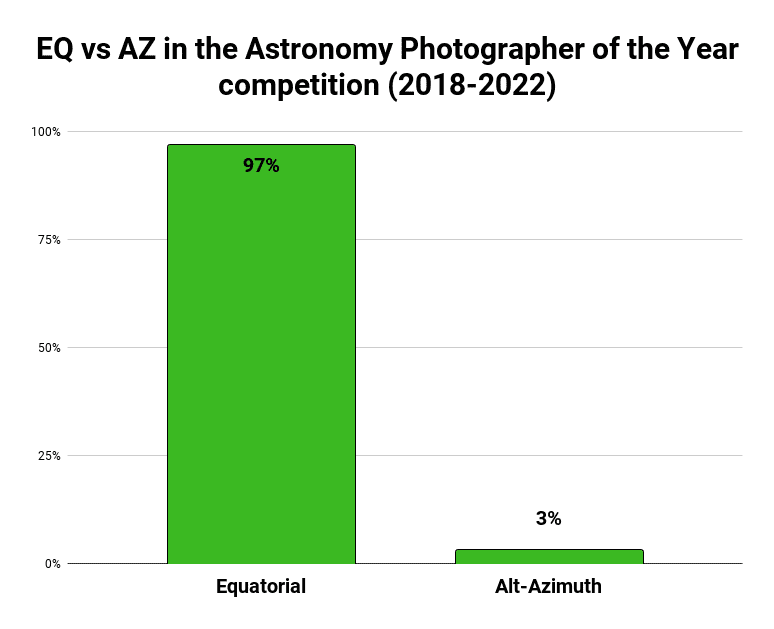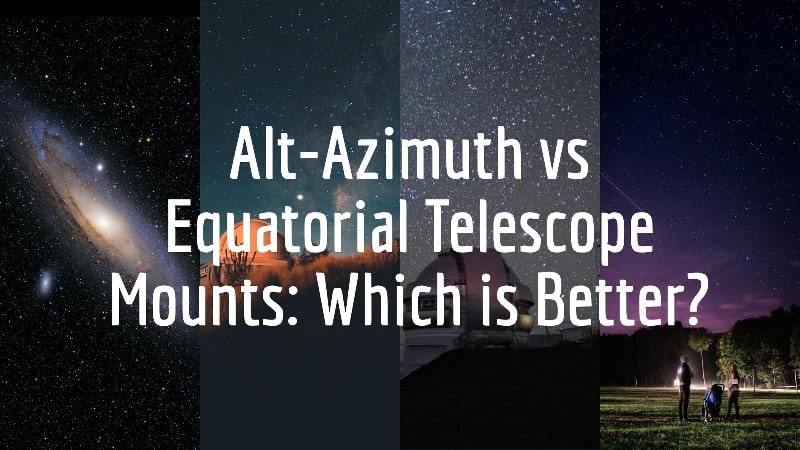If you are looking at buying a telescope it will most likely come with one of two main types of mount: altitude-azimuth or equatorial.
The TLDR on Alt-Azimuth vs Equatorial mounts is:
- Alt-Az mounts are easy to use and good for astronomy and visual observing
- Equatorial mounts are harder to use but are good for astrophotography
Read on to understand why and for some other factors to consider that may be relevant for you.
Alt-Azimuth Telescopes & Mounts
Altitude-Azimuth mounts are often referred to under a number of abbreviations, including:
- AZ
- Alt-Az
- Altazimuth
- Alt-azimuth
These are all the same thing, so don’t get confused by this.
Often the letters “AZ” or “EQ” will be in the name of the telescope package and so let you know what type of mount they are coming with. For example:
- Celestron AstroMaster 130EQ Reflector Telescope – “EQ” means equatorial mount, “130” refers to the aperture in mm of the telescope, and “reflector” is the telescope type.
- Celestron PowerSeeker 50AZ Refractor Telescope – “AZ” means alt-azimuth mount, “50” indicates 50mm aperture, and its a “refractor” telescope.
The reason these are usually in the names is that these are the three most important pieces of information about a telescope package to let you know what it will be good at:
- Telescope Type – Reflector, refractor, or compound/catadioptric (see reflector vs refractor for more on this)
- Telescope Aperture – the best indicator of its viewing capacity (the higher the better)
- Mount Type – AZ or EQ
Many who are new to telescopes might be surprised that AZ or EQ is so important, but it is a great indicator of what – and who – the package will suit.
The name Altitude-Azimuth comes from the combination of these words and indicates how this mount type works:
- Altitude: Moving vertically (up and down)
- Azimuth: Moving horizontally (left and right)
Whilst there are advanced mounts that fall within the alt-az categorization, they are the most common type of mount and are what comes with most basic telescope packages, especially with smaller and cheaper refractor telescopes.
These mounts are operated by hand and allow you to simply point your telescope where you want to look with the up/down, left/right operation.
For telescope beginners, they are simple to operate and make it easy to take the first steps into backyard astronomy.
Alt-Az is actually a categoriztion of telescope mount that includes a number of different mount types, including:
- Pan handle – The simplest and most common alt-azimuth mount type. Controlled with a single arm/handle.
- Slow-motion control – A variation on the above with two turnable handles – one for altitude and one for azimuth. This allows more precise targeting
- Dobsonian – Using a base that sits directly on the ground instead of a tripod and combined with a large reflector telescope.
- Single Arm Mount – Holding the telescope via a single connection on the side and are usually computerized.
- Fork Mount – Holding the telescope with an arm on either side and are usually computerized.
If you want to read more about dobsonian, single arm and fork mounts, as well as computerized/GOTO, then see our article on different types of telescope mounts explained.
Alt-Az Mount Advantages
The main pros of standard alt-az mounts are that they are:
- Simple to use: Intuitive controls mean that anyone can get hold of one and know how to operate it. This is not the case with EQ mounts.
- Easy to set up: They fit together simply and do not need to be aligned or balanced like EQ mounts.
- Small and light: They are not bulky and do not incorporate counterweights, like EQ mounts. This makes them easier to transport and store.
- Cheap: Their simplicity and small size means that they are inexpensive compared to EQ mounts
- Versatile: A refractor on an alt-az mount can be used for terrestrial purposes like bird-watching, but an EQ mount will be very awkward for this.
Alt-Az Mount Disadvantages
The cons of alt-az mounts are that they are:
- Not suited to astrophotography: You need to take long exposures when photographing an astronomical object and so you need to smoothly track it in the night sky. The up-down, left-right movement of alt-az mounts does not suit this.
- Manual control: Basic, non-computerized alt-az mounts require you to manually locate and track anything you want to view. This makes it harder and can be discouraging for a beginner.
Overall, basic alt-az mounts are great for travel telescopes or simple family telescopes that you want to use occasionally in the backyard when you want it to be easy and quick to get going.
Alternatively, dobsonians are a type of alt-az and usually give the best value in terms of aperture to price. The downside is that they are usually very big and bulky and so will not suit everyone.
You can use altazimuth mount telescopes for astrophotography and many will come with smartphone adapters for this, but this will be limited to photographing the moon or maybe some planets in our solar system at certain times (depending on your telescope’s aperture and magnification).
Anything deep sky object that is further away and fainter, like a galaxy, will require a longer exposure for which an alt-az mount will be very limiting.
Equatorial Telescopes & Mounts
Equatorial (EQ) mounts have a declination axis (Dec) and a right ascension axis (RA) that allows the telescope to be moved north and south, and east and west.
The key difference from an AZ mount is that an EQ mount is then polar aligned – this means it is pointed at the north celestial pole. This is the point in the night sky around which all the other stars and astronomical objects rotate.
The EQ mount can then smoothly track objects in the night sky and this makes them much more suitable for astrophotography, where you will take long exposures and need to stay focused on an astronomical object for a long period.
If a telescope package states that it comes with an EQ mount it most likely comes with a German Equatorial Mount (GEM).
However, there are a number of types of mounts that fit within the category of equatorial, including star trackers and fork mounts but also even alt-az mounts fitted with an equatorial wedge. In fact, any mount that can track astronomical objects by turning a single axis is an equatorial mount.
Equatorial Mount Advantages
The main pro of EQ mounts are that they are best for astrophotography.
As noted above, they more precisely track the movement of objects in the night sky on their natural axis and allow for longer photographic exposures to be taken in order to capture the neccessary light for imaging faint objects.
Equatorial Mount Disadvantages
The cons of EQ mounts mostly relate to practicality and ease of use. They are:
- Harder to use: EQ mounts have a more complex setup process and need to be aligned and balanced correctly.
- Heavier: EQ mounts are larger and include heavy counterweights. This makes them less portable.
- Bulkier – EQ mounts are larger and so harder to pack up and store, as well as travel with.
Overall, EQ mounts are necessary for serious astrophotography but are not easy for beginners.
Equatorial vs Alt-Azimuth for Astrophotography
As noted above, EQ mounts are considered better than AZ mounts for astrophotography, but we also have the data to back this up.
We analyzed nearly 700 images shortlisted for the world’s leading astrophotography competition in the past five years to see what gear was used and this included telescope mounts.
If we look specifically at the number of images shortlisted using EQ and AZ mounts (260 photos) then you can see that EQ mounts are far more sucessfully used:

See Astronomy Photographer of the Year Equipment Analysis if you want to see the full data.
Equatorial Mount vs Altazimuth FAQs
What is the difference between an Alt-Azimuth (AZ) and an Equatorial (EQ) mount?
Alt-Azimuth telescopes and mounts are simple to use and are best for basic astronomy and visual observation.
Equatorial mounts are best for astrophotography as they can smoothly track night sky objects but they are harder to master. They are also heavier and bulkier and so harder to store and travel with.
Are Equatorial or Altazimuth Mounts Better for Astrophotography?
Equatorial mounts are better for astrophotography because they allow astronomical objects to be tracked smoothly on a single axis in the night sky when being imaged.
Alt-az mounts are limited for astrophotography because they can only move up and down, left and right and this does not match how objects move in the sky.
This is a problem because you need to take long exposures for astrophotography and track the object you are trying to photograph.
What are Hybrid (AZ/EQ) Mounts?
Hybrid Mounts are often called AZ/EQ mounts and can be used as either alt-az or equatorial mounts.
The advantage of this is that you can have the simplicity of the Alt-Az mode for observing, but also the capacity for astrophotography use by switching into the EQ mode.
The downside of Hybrid Mounts is that they are more expensive than standalone Alt-Az or EQ mounts.
Verdict: Alt-Azimuth Mount vs Equatorial
Alt-azimuth mounts are great for basic telescope packages for backyard family use and travel as they are easy to use and small and light.
They can be perfect for a first telescope package as they are easy to get to grips with and I have seen many cases of people going for EQ-mounted telescopes as beginners because they want to take photos but getting quickly discouraged by how hard it is to use.
Without a doubt, EQ mounts are better for astrophotography but you need to be prepared to invest the time to master it and also be aware of the weight and size as this can be a factor for people with limited space at home.
Related articles:



